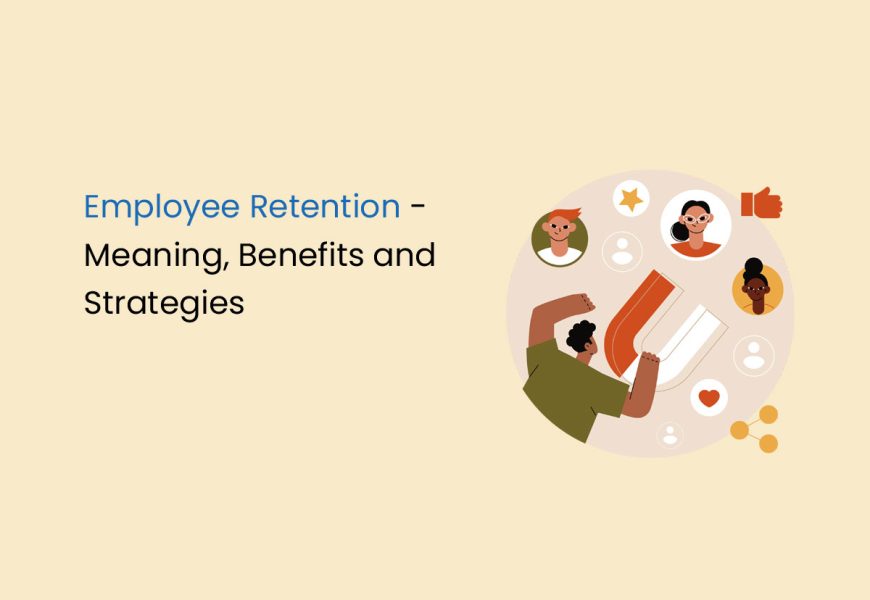Employee retention is vital to maintaining a stable and productive workforce. In today’s competitive job market, where skilled workers are in high demand, keeping top talent can be challenging. If turnover rates are high, it can lead to increased recruitment costs, loss of knowledge, and low morale among remaining employees. For this reason, businesses should prioritise strategies for employee retention. This will create loyalty, engagement, and long-term success.
This blog will examine employee retention, its meaning, benefits and some effective strategies.
What is Employee Retention?
Employee retention is when an organisation can keep employees engaged, satisfied, and committed to their jobs and the company by creating a positive work environment that promotes engagement, shows appreciation, offers competitive pay and benefits, and encourages a healthy work-life balance.
Importance of Employee Retention
Employee retention is crucial for building cohesive teams, maintaining productivity, and preserving competitive advantage. High turnover rates can severely impair an organisation’s ability to maintain momentum and deliver results, disrupt workflow, hamper project continuity, and lead to loss of institutional knowledge. It can also harm the organisation’s morale and negatively impact customer perceptions and relationships. Thus, organisations must prioritise strategies to foster a supportive work environment, provide opportunities for growth and development, and recognise and reward employee contributions to sustain long-term success.
Benefits of Employee Retention
The benefits of employee retention are as follows:
- Recruitment and Training Efficiency: Retaining employees financially benefits companies by reducing recruiting and training costs. A stable workforce enhances a company’s reputation and attracts top talent. Moreover, a positive work environment boosts employee satisfaction and drives better business outcomes.
- Increased Productivity: Employee turnover hampers productivity and can decrease output and efficiency. It also strains the remaining staff, resulting in burnout or decreased morale. Conversely, high retention rates lead to engaged employees who are more productive and contribute to a positive work environment. Reducing employee turnover fosters a culture of engagement and commitment, ultimately driving higher performance and organisational success.
- Improve Employee Morale: Employee retention is crucial for organisations as it helps build a culture of connectedness and engagement. It enhances morale and serves as a powerful catalyst for retention efforts. A constant turnover of employees can lead to decreased morale and motivation. By prioritising employee retention, organisations can create a positive work environment where employees feel valued, supported, and motivated to contribute their best efforts. Ultimately, this improves retention rates and enhances overall organisational performance and success.
- Experienced Employees: Long-tenured employees are valuable assets to an organisation due to their deep insights, relationships, and institutional knowledge. When they leave, the company faces opportunity costs and disruptions. Organisations should prioritise employee retention by investing in initiatives that promote engagement, career development, and a positive work environment to mitigate these costs.
- Better Customer Experience: Experienced employees are crucial for providing an excellent customer experience and building customer loyalty. They possess the skills and insight needed to address customer needs effectively. By investing in employee retention initiatives, organisations can establish a reputation for excellence and set themselves apart from competitors.
- Improved Employee Satisfaction and Experience: Employee satisfaction and engagement are critical factors in determining whether employees stay with an organisation. Companies that prioritise these factors tend to experience higher retention rates. Conversely, organisations with high retention rates often have greater employee satisfaction and engagement. By fostering a culture prioritising these factors, organisations can create a virtuous retention cycle, leading to increased productivity, innovation, and overall success.
- More robust Corporate Culture: A strong corporate culture is shaped and reinforced by engaged employees aligned with the organisation’s values and mission. This creates a positive workplace culture, fosters a sense of belonging, and increases collaboration and productivity. Engaged employees contribute to the long-term success and sustainability of the organisation by supporting its goals and exhibiting behaviours that support organisational success.
- Increased Revenue: Employers should understand that employee retention is not only about reducing costs; it can also positively impact revenue. Anecdotal evidence shows that companies with better retention rates deliver a better experience for both their customers and employees. Additionally, these companies retain experienced top talent and are more productive, which can lead to growth.
What happens when there is a High Employee Turnover?
High employee turnover can present significant organisational challenges, resulting in resource losses, lowered morale, and decreased productivity. Organisations should minimise excessive attrition by implementing retention strategies such as providing career development opportunities, fostering a positive work culture, and offering competitive compensation and benefits. Organisations can cultivate a stable and engaged workforce by prioritising efforts to retain talent, driving sustained success and growth.
Causes of Low Employee Retention
The causes of low employee retention are as follows:
- Low Morale: How employees perceive their work experience can significantly impact their decision to stay with a company. Factors such as recent layoffs, changes in upper management, or adverse public image can lead employees to consider seeking employment elsewhere.
- Disengagement: Sometimes, employees may want to find a new job because they feel disconnected from their coworkers or the company. This can happen in larger companies where employees might feel like they’re not involved in decision-making. Additionally, it can be challenging for them to express their thoughts or concerns when there are so many other employees and many layers of management above them.
- Boredom: Employees feel more motivated and satisfied when they understand their job’s purpose and feel that their work is meaningful. If they sense that their work lacks purpose, they may consider finding a job that allows them to use their skills more effectively.
- Feeling Overworked: An excessive workload and time constraints can increase stress levels, leading to decreased motivation and burnout, ultimately resulting in low employee retention.
- Lack of Clear Advancement Opportunities: If employees have been working for a few years, performing well within their role, and perhaps even receiving praise for their work, they may expect management to consider them for promotions. However, if management doesn’t discuss career advancement with them or show them how to move forward, the employee may start considering leaving the job.
- Inadequate Salary: If an employee’s salary does not increase to meet their current needs, they might start looking for a job that pays better. This could be because the current management has not offered them a raise in a long time, despite their excellent work and increased skill level. These factors could make an employee consider searching for a new job opportunity.
- Lack of Development Opportunities: Numerous businesses provide employees with classes and mentorship programs to enhance their personal and professional skills. If the management does not offer such training or guidance, the employees may feel that switching jobs is the only way to advance their careers and develop their abilities.
- Inadequate Benefits: Many companies provide their full-time staff with additional benefits like paid leave, health insurance and company shares. If such benefits are absent or insufficient, employees may search for jobs with employers who provide a better benefits package that suits their requirements.
How to Improve Employee Retention
The following are some employee retention strategies:
- Involved Onboarding Process: Effective employee retention starts with a well-structured hiring and onboarding process that provides comprehensive training, introduces organisational culture and values, and fosters open communication and trust. A welcoming and inclusive environment that integrates new hires into the community can promote long-term engagement and commitment. Prioritising the hiring and onboarding process can enhance employee satisfaction, engagement, and retention, ultimately attracting and retaining top talent.
- Training, Education and Development: Companies offer employees opportunities for growth and advancement through various programs such as upskilling, career development, succession planning, and mentorship. This helps them acquire new skills, stay updated with industry advancements, identify high-potential talent, and cultivate a pipeline of future leaders. These programs also provide employees with valuable guidance, support, and career advice and help companies demonstrate their commitment to investing in their workforce.
- Transparency: When a company is transparent with its employees, there is clear communication between the two parties, and the employees know the company’s vision and goals. Transparency can also involve having an ‘open door’ policy that allows employees to share their concerns with management without fearing punishment. In this way, employees feel comfortable knowing that the company has nothing to hide, and their opinions and suggestions for improvement or concerns will be valued and heard.
- Recognition, Rewards and Compensation: Some organisations use rewards strategies to value their employees. Employers use employee engagement software to recognise workers and provide perks like discounts. They also focus on competitive pay using compensation management software to match pay rates with benchmarks.
- Performance Feedback and Reviews: Many companies have moved away from annual performance reviews to facilitate effective communication and transparency, particularly in light of the rise of remote and hybrid workforces. Instead, managers regularly schedule one-on-one meetings with their employees to offer constructive feedback, discuss their professional aspirations and objectives, and encourage innovative ideas.
- Benefits: Employers strive to differentiate themselves in the hiring process by providing various benefits. These benefits may include voluntary options, where employees pay for their benefits and employer-subsidised benefits. New benefits include health insurance plans with lower premiums and higher deductibles, pet insurance, education debt repayment programs, and legal counselling.
- Perks: Many companies now prioritise promoting a healthy work-life balance through flexible schedules, generous time-off policies, and remote work options. Employees can enjoy shorter work weeks, take extended vacations, or even work remotely from home or holiday locations. Managers are also being trained to encourage employees to take time off to recharge and enhance productivity. These measures aim to support employee well-being while maintaining productivity and engagement.
- Amenities: Employers increasingly offer office perks such as ergonomic and standing desks, subsidised meals, complimentary refreshments, daycare, elderly care, and relaxation hubs featuring games like ping-pong and pool.
Conclusion
Retaining employees is vital for a successful organisation. Prioritising employee satisfaction, engagement, and well-being creates a positive work environment, which fosters loyalty, productivity, and continuous improvement. Investing in employee retention reduces turnover costs and cultivates a culture of commitment to the company’s success.
Frequently Asked Questions
What are the 3 R’s of employee retention?
The three R’s of employee retention are respect, recognition, and reward.
What are the factors of employee retention?
The factors affecting employee retention are as follows:
- Compensation and Benefits
- Work-Life Balance
- Career Development Opportunities
- Managerial Support
- Organisational Culture
- Employee Engagement
- Work Environment
- Job Satisfaction
Why is employee retention an issue?
High employee turnover and retention issues can be very costly for businesses. Gallup estimates that it can cost one-half to two times an employee's annual salary to replace them due to hiring costs, training fees, and lost productivity.
How do you increase staff retention?
Improving employee retention starts by hiring the right fit, following strategic onboarding, and increasing employee retention, engagement, and commitment. Meaningful work, competitive salaries, bonuses, and health benefits also contribute to retention.
What contributes to employee retention?
Organisations retain employees who value meaningful work, career growth, competitive salaries, and benefits.
What are the five primary drivers of retention?
Employees stay on the job when treated with respect, receive fair compensation, feel trusted and empowered, have job security, and can utilise their skills and abilities.
Why is employee retention necessary to HR?
Retention is crucial for organisational stability and growth, as high turnover is expensive and affects company morale.
How can companies improve employee retention?
Companies can improve employee retention by offering competitive compensation, creating a positive work environment, and providing growth opportunities to enhance retention.
What are the consequences of low employee retention?
Companies face higher recruitment costs, lost productivity, and decreased team morale.





















